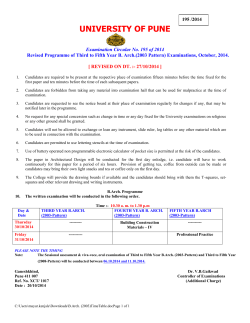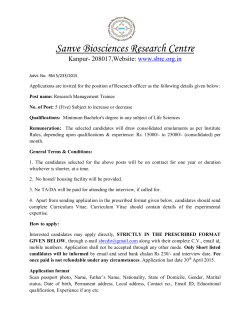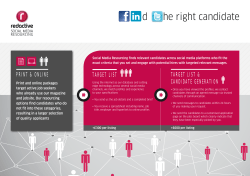
Visual Arts Questionnaire
Continual Renewal from Strength to Strength New Academic Structure Medium-term Review and Beyond Extended Consultation Visual Arts Purpose of the Questionnaire The November 2014 to January 2015 School Survey for the New Academic Structure (NAS) Medium-term Review and Beyond has been completed. In light of the responses and comments collected through the questionnaire survey and feedback collected from other stakeholders, we would like to consult schools on further details related to some of the recommendations proposed in the November 2014 survey. The feedback collected from this Extended Consultation questionnaire survey, in conjunction with the feedback collected from the November 2014 survey and from other stakeholders and sources, will inform the professional discussion in the relevant committees of the Curriculum Development Council (CDC) and Hong Kong Examinations and Assessment Authority (HKEAA), for further deliberation at the Joint CDC–HKEAA Public Examinations Board (CDC–PEB) meeting on the last batch of recommendations to be announced in July 2015 or before. This questionnaire aims to solicit the views of subject panel heads and teachers on further details related to some of the recommendations proposed in the November 2014 survey. Subject panel heads and teachers are advised to exchange their views before responding to the questions. The items are by no means exhaustive, and views on those that are not included can be collected through other channels, e.g. written submissions, briefings, forums and interviews. Subject panel heads and teachers are also welcome to express their views under ‘Other comments’ in this questionnaire. Briefing sessions for schools will be held on 31 March and 1 April 2015 to explain the proposed recommendations and to collect feedback. Please refer to the Training Calendar System for details. Guiding Principles Following the completion of the Short-term Review in April 2013 and announcement of 1st batch of recommendations of the Medium-term Review in April 2014, the NAS Medium-term Review continues to adopt a student-centred approach and the guiding principles below: 1. Gear all curricula towards achieving the overall learning goals for secondary education; 2. Keep abreast of the latest changes in the disciplines of knowledge, economic, social and technological contexts, etc. with regular international benchmarking and recognition; 3. Strike a balance between breadth and depth in knowledge, skills, positive values and attitudes in school curricula appropriate to secondary education and interface with further studies; 4. Cater for student diversity and build on strengths (e.g. personal effort, subject interest, teaching method, and curriculum content are recognised by students as most important factors for success in senior secondary education); 5. Consider factors and concerns regarding implementation (e.g. workload of teachers and students, support to teachers); 6. Align assessment with curriculum aims, learning objectives, curriculum design and expected learning outcomes; 7. Engage different stakeholders and consider the feedback collected from different sources to inform deliberations in relevant CDC and HKEAA committees. While the short-term review placed emphasis on practical concerns regarding implementation and catering for student diversity, the Medium-term Review also emphasises the need to address the latest changes in the disciplines of knowledge, economic, social and technological contexts, etc. with regular international benchmarking and recognition, with a view to forming a good foundation in moving towards the continual renewal of curriculum and assessment under “Learning to Learn 2.0”. Return of Questionnaires For each subject, schools are expected to return ONE questionnaire only. The panel head should consolidate all views on this questionnaire and return it to the Principal/coordinator, who will collect all relevant Subject Level Questionnaires and return by hand using the self-addressed envelope enclosed, to the Council and Secondary Section, Curriculum Development Institute (Room 1302, 13/F, Wu Chung House, 213 Queen’s Road East, Wanchai, Hong Kong) on or before 24 April 2015. For general enquiries, please contact Ms Zita YIM at 2892 5810. For enquiries on the recommendations for the medium-term and beyond, please contact Ms HO Pui-fan at 3698 3538. All information provided will be kept strictly confidential and will only be used for the purpose of the NAS Review. No information on individual schools/teachers will be revealed. Visual Arts Page 1 of 5 School Name: _________________________________________________ School Number: Name of Contact Person: ______________________________ (Tel) _________________ Visual Arts Background In light of the feedback collected from the November 2014 survey, we would like to seek further views from schools regarding the following: If contents, i.e. knowledge and skills, are to be further specified both for the curriculum and assessment in the long term, your views on the detailed arrangements; If the linkage between art appreciation and criticism and art making is to be relaxed in the public examination, your views on the detailed arrangements; and If guided questions for assessing art appreciation and criticism are to be introduced in the public examination, your views on the detailed arrangements. Please blacken the appropriate circle. space provided when necessary. 1. Background Information: State your comments and provide information in the Please indicate the provision of this subject in your school: ○ This subject is offered in the 2014/15 school year and/or was offered in previous school year(s) ○ This subject has not been offered Visual Arts Page 2 of 5 Recommendations for the Medium-term and Beyond Curriculum 2. In the Visual Arts Curriculum and Assessment Guide (S4 – 6) (p.11) learning contents refers to knowledge and skills as stipulated in ‘Learning Objectives and Opportunities’, e.g. formal knowledge, modes of artistic presentation, etc. (Please refer to Annex 1) The SS Visual Arts curriculum focuses on developing students’ different abilities in visual arts, and it provides flexibility for teachers and students to select learning and teaching materials to cater for learner diversity (e.g. interests, abilities, career aspirations). On the need to specify contents BOTH in the curriculum and assessment in the long term, schools’ views are further solicited as follows: To help students with diverse learning needs to develop knowledge, skills and attitudes in Visual Arts, there is a need to maintain the existing flexibility of learning contents as stipulated in the current Curriculum and Assessment Guide. ○ Agree Please give your reasons and any suggestions (e.g. teaching strategies, good practices, learning and teaching materials, etc.), if any, for enhancing the implementation of SS Visual Arts curriculum and assessment, based on the existing curriculum and assessment framework. ○ No opinion ○ Disagree (Please specify your reasons and suggest how contents, i.e. knowledge and skills, are to be further specified BOTH for the curriculum and assessment in the long term): Reasons: (Please choose not more than TWO options) ○ Lesson time, please specify: ○ Depth of the stipulated learning contents, please specify: ○ Breadth of the stipulated learning contents, please specify: ○ Others, please specify: Suggestions: (Please choose not more than TWO options) ○ Illustrate the stipulated learning contents with more examples of curriculum design and assessment ○ Provide a frame of perspectives for understanding art e.g. personal and psychological, formal, social and cultural, etc. ○ Provide suggested reading materials, which are NOT to be memorised for assessment, please specify: ○ Others, please specify: Visual Arts Page 3 of 5 Assessment 3. (a) If the existing requirement of linking art appreciation and criticism with art making in the public examination of HKDSE Visual Arts is to be relaxed, please indicate your views on the following proposed changes to both Papers 1 and 2: Examination Arrangement If the linkage between art appreciation and criticism with art making in the public examination in both Papers 1 and 2 is to be relaxed, candidates are still required to complete Parts A and B. However, they will no longer be required to write an artwork/design work statement in response to the relationship between the practical work and the appreciation of artwork. Agree Disagree No opinion ○ ○ ○ ○ ○ ○ ○ ○ ○ Other comments If necessary, candidates may submit a creative/design brief which may include notes, sketches or layouts produced during the examination to support their artwork/design work. The practical work and the creative/design brief will be assessed as a whole and no separate marks will be awarded to the notes, sketches and layouts. The proposed Assessment Framework is shown in Annex 2. Do you agree to the proposed changes to Papers 1 and 2? (b) Marking Criteria Subsequent to the arrangement delineated in Q3(a), the criterion ‘Relationship between Practical Artwork and Appreciation & Criticism’ will be deleted from the Marking Criteria for Part B of both papers. The other four criteria will be kept, and they will carry a total of 80 marks. Details of the revised mark allocation are shown in Annex 3. Do you agree to the proposed changes to the Marking Criteria of Part B of both papers? (c) Year of Implementation If the above proposals are to be implemented, they should be implemented with effect from the 2018 HKDSE Examination (S4 students in 2015/16)? Visual Arts Page 4 of 5 4. (a) Under the current mode of examination, Part A of questions in both Papers 1 and 2 are open-ended in nature and candidates are required to present their answers in a holistic manner. If guided questions are to be provided with an aim to help more effectively cater for students’ learning diversity, it would mean that in Part A, sub-questions requesting answers with specific content will be asked. Annex 4 shows some sample guided questions. Which of the following question types would you prefer for Part A of both Papers 1 and 2 in the public examination? ○ Guided Questions: (e.g. breaking down questions into sub-questions, providing information to guide candidates to answer the question, etc.) ○ Current mode (Short essay question requesting a holistic and more open-ended response) ○ Others (please specify): _____________________________________________________________________________ _____________________________________________________________________________ (b) If the above proposal is to be implemented, please indicate below the earliest year of implementation preferred: ○ S4 students in 2015/16 (2018 HKDSE Examination) ○ S4 students in 2016/17 (2019 HKDSE Examination) ○ No opinion Other comments: ___________________________________________________________________ __________________________________________________________________________________ – The End – Thank you very much! Visual Arts Page 5 of 5 Annex 1 Annex 2 PROPOSED 2018 HKDSE VISUAL ARTS ASSESSMENT FRAMEWORK INTRODUCTION The public assessment of this subject is based on the Visual Arts Curriculum and Assessment Guide (Secondary 4─6) jointly prepared by the Curriculum Development Council and the Hong Kong Examinations and Assessment Authority. Candidates have to refer to the Guide for the knowledge, understanding, skills etc. they are required to demonstrate in the assessment. ASSESSMENT OBJECTIVES The objectives of the public examination include the assessment of candidates’ ability to: describe, analyse, interpret and evaluate artwork in writing; relate their critical responses to artwork with their own art making; select and manipulate visual language, media, materials, tools and techniques appropriate for the creative expression and communication of a topic/theme or for solving a particular problem. The objectives of SBA include the assessment of candidates’ ability to: generate ideas through observation, experience, imagination, technology and other skills; develop themes of personal feelings or ideas, or social-related issues or ideas for problem solving through identifying, selecting and organising primary and secondary resources; analyse, interpret and make critical judgment of artwork/art phenomena showing understanding of form, purpose, meaning and context in writing; transform and integrate experiences, knowledge and perspectives constructed from art appreciation and criticism, and other areas into art making practice; explore, select and manipulate appropriate visual language, media, materials, tools, skills, techniques and imagery for creative expression and communication of a theme or for the solving of a particular problem; continuously reflect on, respond to and evaluate their own and others’ practice and work, and consequently modify their own work. MODE OF ASSESSMENT The public assessment will consist of a public examination component and a school-based assessment component as outlined in the following table: Component Public Examination Choose either Paper 1 or Paper 2. Weighting 50% Paper 1- Visual presentation of a theme Paper 2- Design School-based Assessment (SBA) Each paper is divided into two parts: Part A (10%) Part B (40%) Submit ONE portfolio which should consist of: (a) Research workbook (20%) (b) Artwork/Critical studies (30%) 2018-HKDSE-V ARTS 50% Duration 4 hours PUBLIC EXAMINATION The overall rationale of the public examination in Visual Arts is to assess candidates’ performance in the visual arts. Both written presentation on critical appreciation of works of art from personal knowledge and production of a work of art will be used to assess candidates’ performance in a broad range of skills and abilities in the two learning strands: visual arts appreciation and criticism in context and visual arts making. Candidates must attempt ONE of the following examination papers. Each paper provides a choice of five questions. Each question provides reproduction artwork and may include relevant reference information for appreciation. Candidates are allowed to use reference materials during the examination. Paper 1: Visual Presentation of a Theme Candidates are required to work in two dimensions in any media, style or technique, choosing one question from the five given, and to work on the following two parts: Part A: Art Appreciation and Criticism (45 minutes) Write a critical appreciation of the reproductions of artwork provided. Part B: Visual Arts Making (3 hours and 15 minutes) Create a piece of artwork to present a theme. Candidates may submit a creative brief which may include notes, sketches or layouts produced during the examination to support their artwork, if necessary. The practical work and the creative brief will be assessed as a whole and no separate marks will be awarded to the creative brief. and present an artwork statement (about 50 words) in response to the relationship between the practical work and the appreciation of artwork. The practical work and the creative brief artwork statement will be assessed as a whole. The theme(s) are deliberately broad, giving candidates as much freedom as possible for their interpretation. This examination paper will assess candidates’ understanding and appreciation of artwork and artistic visual presentation of a theme. Paper 2: Design Candidates are required to design in any media, style or technique choosing one question from the five given, and to work on the following two parts: Part A: Design Appreciation and Criticism (45 minutes) Write a critical appreciation of the reproductions of design provided. Part B: Design (3 hours and 15 minutes) Solve design problem(s) and present a design work. Candidates may submit a design brief which may include notes, sketches or layouts produced during the examination to support their design work, if necessary. The practical work and the design brief will be assessed as a whole and no separate marks will be awarded to the design brief. work statement (about 50 words) in response to the relationship between the practical work and the appreciation of design(s). The practical work and the design brief work statement will be assessed as a whole. Examples of problems set may be a poster, a greeting card, signage, stationery, a book, a journal, packaging, a toy, fashion and accessories, etc. This examination paper will assess candidates’ understanding of design and their ability to solve given design problem(s) in any innovative way. 2018-HKDSE-V ARTS SCHOOL-BASED ASSESSMENT (SBA) SBA is compulsory for all school candidates. Candidates will be assessed by portfolios, which enable the assessment of candidates’ sustained work and provide a more comprehensive picture of their performance throughout the period of study. Details of the SBA assessment requirements are as follows: Assessment task One Portfolio Subject weighting Research workbook 20% Four pieces of Artwork / Critical Studies (of which at least one piece of work must be an Artwork) 30% Candidates are required to submit ONE portfolio which should consist of: (a) Research Workbook (presentations on art appreciation and criticism in context in relation to art making/critical studies and research processes) showing: evidence (e.g. sketches, photographs, notes) of how ideas are generated and recorded through observation, experience, imagination, technology and other skills; exploration and development of a theme/topic for art appreciation and criticism, and art making; presentations on art appreciation and criticism in context in relation to art making/critical studies, with evidence of research into the socio-cultural and historical contexts of more than one culture; and criticism of artwork/art phenomena/visual cultures from different perspectives and with different aesthetic values to the candidates’ own; how artists’ work has influenced their own art making/critical studies; exploration of and experimentation with media, materials, skills and techniques for the presentation of the selected theme; reflection on, evaluation of and refining of their own work; and (b) Artwork/Critical studies (four pieces of work in the portfolio) for the presentation of the selected theme(s): All of the four pieces of work can be artwork, or one to three pieces of them can be critical studies; Any media, materials, skills and techniques can be used for the production of the artwork. Candidates are required to keep good custody of their work for inspection and authentication purposes until the release of the HKDSE results. Private candidates are required to submit ONE portfolio which should consist of a research workbook and two pieces of Artwork / Critical Studies (at least one piece of work must be an Artwork) to the HKEAA for assessment, which will constitute 50% of the final subject mark. The detailed requirements, regulations, assessment criteria and guidelines are provided in the SBA Handbook for HKDSE Visual Arts published by the Hong Kong Examinations and Assessment Authority. 2018-HKDSE-V ARTS Annex 3 Hong Kong Diploma of Secondary Education Examination Visual Arts Revised Marking Criteria for Part B With the relaxation of the linkage between art appreciation and criticism with art making in the pubic examination, the following changes are proposed to the marking criteria of Part B of Papers1 and 2: (a) The criterion “Relationship between Practical Work and Appreciation and Criticism of the Artwork” will be deleted. (b) The other four criteria will be kept, and they will carry a total of 80 marks. The revised mark allocation of Part B is shown below. Marks/ Rubrics High Middle Low Not Shown 0 Marking Criteria Selection and Use of Materials & Technique Selection and Use of Visual Elements and Principles of Design Creativity & Imagination Communication of Theme 17-20 Able to select and master the materials and the skills accurately and effectively in implementing the key message of the theme Able to select and master multiple visual elements and principles of design, accurately and effectively in implementing the key message of the theme Able to demonstrate personality characteristics through originality and unique imagination 13-16 Able to master the materials and the skills appropriately and effectively in outstanding the key message of the theme 9-12 Able to master the materials and the skills appropriately in delivering the key message of the theme 5-8 Able to use the materials and the skills relevant to the theme 1-4 Unable to use the materials and the skills to cope with the theme Able to master multiple visual elements and principles of design appropriately and effectively in outstanding the key message of the theme Able to master the visual elements and principles of design appropriately in delivering the key message of the theme Able to use the visual elements and principles of design relevant to the theme Unable to use the visual elements and principles of design to cope with the theme Able to demonstrate personality characteristics through originality and rich imagination Able to demonstrate personality characteristics or originality Unable to show personality characteristics or originality Able to integrate relevant forms of artistic creation in different emotions or idea Able to use multiple, relevant and coordinate forms of artistic creation in different emotions or idea Able to demonstrate personality characteristics through originality and by means of transference or association Able to use relevant and coordinate forms of artistic creation in different emotions or idea Only use irrelevant forms of artistic creation in different emotions or idea Unable to use any relevant forms of artistic creation in different emotions or idea Annex 4 HONG KONG DIPLOMA OF SECONDARY EDUCATION EXAMINATION VISUAL ARTS SAMPLE QUESTION Sample One Paper 1 Visua l P rese ntat io n of a The me 1. (A) (i) Describe and compare Plates (1a) and (1b) in any three of the following aspects: Lines Colour Medium Perspective Theme Others (5 marks) (ii) Based on the description in (i), analyse, interpret and evaluate these two pieces of artwork. (15 marks) Plate (1a) Fang Zhaoling ( 方 召 麐 ). Climbing to the Top of Huang Shan ( 黃 山 ). 1987. Chinese ink and colour on paper, 96.5 x 61.5 cm. Plate (1b) (B) Katsushika Hokusai (葛 飾 北 齋 ) . Thirty-six Views of Mt. Fuji–Ejiri in Suruga Province (冨 嶽 三 十 六 景 – 駿 州 江 尻 ). 1831. Colour woodblock print, 26 x 38.5 cm. (Note: Ejiri is the name of a place in ancient Japan) Create a piece of two-dimensional work based on the theme “Travelogue”. (80 marks) S a m p l e Tw o Paper 2 Design (A) Describe, analyse and compare Plate (1a) and Plate (1b), with respect to aspects of design concepts, visual effects and communication effects, such as images, colour, typography, composition, purpose, etc.. Hence interpret and evaluate these two graphic designs. (20marks) Plate (1a) Poster for Visiting England Plate (1b) Typography Design (LIFE IS THE ILLUSION.LOVE IS THE DREAM) (B) Create a design with typography (in Chinese, English or both Chinese and English) for the phrase – Sunshine” ( 雨 過 天 晴 ) . Images may be included in the design. “After Rain Comes (80 marks)
© Copyright 2025









